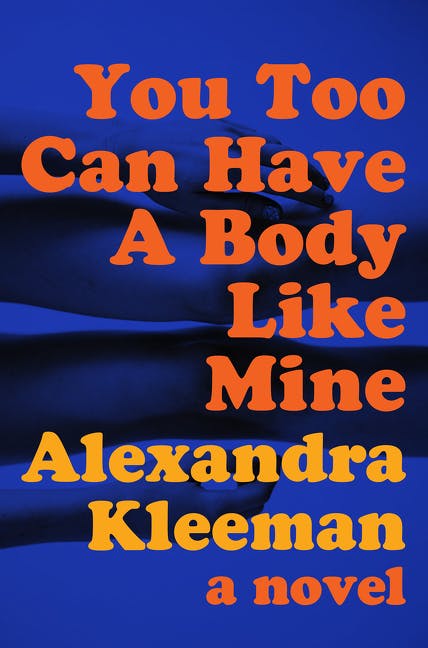A common complaint about recent developments in dating is that there is now too much choice. In Nancy Jo Sales’s recent Vanity Fair article about Tinder, an investment banker named “Dan” compared the dating app to an online food delivery service: “It’s like ordering Seamless ... But you’re ordering a person,” he said. Sales reported mixed feelings, rather than a consensus, about the technology’s efficiency: some complained it made finding sex partners “too easy,” or that it encouraged bad manners. The piece argued that the technology we use to hook up has changed or is changing how we see other people and experience desire.

The young female narrator (whose name is A), in Alexandra Kleeman’s debut novel, You Too Can Have a Body Like Mine doesn’t use Tinder. The internet barely appears in the novel, in fact. And she only has one sex partner, a boyfriend named C. But the novel, like Kleeman’s earlier writing, explores questions about wanting and having and bodies and food and sex that often arise in discussions about how people date today. Her short story, “Fairy Tale,” published in The Paris Review in 2010—before the invention of Tinder but post-OK Cupid—reads like a parable about overabundance and choice. It begins when a woman is struck by amnesia, just as she is announcing engagement plans to her parents; suddenly she doesn’t recognize her fiancé. As she tries to regain her bearings, the doorbell rings. Men trickle into the house. “We're your boyfriends, partners, paramours,” they respond when she asks who they are. “I didn’t know anything about any of them, in fact I could barely tell them apart.”
The title “Fairy Tale” gestures back to a genre in which romance meant princesses choosing from a line-up of suitors, but the narrator is uncomfortable picking from a group of men who all seem the same. The story is absurd and darkly funny, like the opening episode of any season of The Bachelorette, in which a woman must choose which of the roughly thirty male contestants—usually they’re almost all white and tall, with full heads of hair and straight teeth, wearing suits—she wants to send home, the first step in her quest to whittle the pack down to one man she’d like to marry. Unlike the ABC show’s real heroine (or the princesses of the past?), Kleeman’s narrator doesn’t have weeks to sort the wheat from the chaff. Just before her mother asks which one she will be choosing, she thinks about “the structural similarity of men and their ability to be represented both as ideal, like the Vitruvian of Da Vinci, and as average.” She decides to talk with “the one who had brought flowers,” but he tells her he’s trying to kill her. She’s still trying to escape from him when the story ends.
In Kleeman’s new novel, A also questions the idea that there is something unique about the people around her: “Sometimes I thought about C and the idea came to me that any man's genitalia, however large or weirdly shaped, would be guaranteed to fit inside my own. Our pairing was coincidental or, at best, lucky.” Characters are often mistaken for one another. A’s roommate B cuts her hair and applies make-up to look just like A. A, half asleep and dreaming, thinks she’s looking at her own body from the outside, but it’s B stood by her bed. Later, A drifts into a cult where she must renounce her identity, wear a Halloween-ish white sheet with eyeholes, and strive to forget the existence of her loved ones.
The novel is split into three parts, and in the first third, A is suffering from a modern kind of ennui. She rarely travels far from a TV set, and often feels sleepy, and disconnected from or misunderstood by those around her. The characters watch game shows, Shark Week, commercials, and a chat show interview with a man convicted of stealing, hoarding, and eventually eating large quantities of veal from a supermarket (“I couldn’t do anything for the calves, he said. I’m just one man. But I thought to myself: I can do something for these cutlets.”) Most of the book’s detail is like this—weird and funny, but with a cruel underbelly and dogged by flawed logic. It’s rarely clear who the butt of the joke is (perhaps it’s us?).
A’s anxiety about finding others indistinguishable is also a worry about how they see her. On a game show she hates but watches anyway with C called That’s My Partner! couples compete to prove how well they know each other. In the final round, one half of the duo is sent into a pitch-dark room filled with naked people. Using touch, the contestant has three minutes to find the person they love. If they get it right, they win a cash prize. If they lose, the couple is served with a bidirectional restraining order. A worries that if she went on the show with C, he wouldn’t recognize her. When he half-jokingly suggests they apply, they fight and he stops returning her calls.
When the Paris Review interviewed Kleeman about “Fairy Tale,” she gave an interesting answer about characters:
I often have to tell myself, you’re a graduate student, you’re a daughter, et cetera, in situations where I’m supposed to behave like one. We talk about characters in literature as though they were built on the model of the real person, but then I often think that the way we present ourselves as real people is based heavily on the way literary psychologies are stylized, and I wonder how the two forms of realistic personhood feed on or fulfill each other. I find an incredible amount of pressure in creating a realistic person or in being a realistic person.
Kleeman’s characters in You Too Can Have A Body Like Mine sometimes appear barely alive—affectless, disengaged, lethargic—but this might be because she is choosing to portray a type not usually at the center of novels. A, B, and C are drifters, but unlike Jack Kerouac’s characters they don’t travel anywhere. This gives the novel an aimless feeling—none of the characters is pursuing money, love, fame, revenge, or any other quest that might drive a narrative forward. They fill their free time with distractions. In the book’s sex scene, A speculates to herself about why C likes to watch porn and have sex at the same time (she doesn’t ask why, but decides “it had to do with the thinness of the present”), and fantasizes about having an orgy with C and all of her ex-boyfriends “to fill up the residual mental spaces that the act never seemed fully able to occupy on its own.”
The transferral of desires from screens to minds is one of the book’s central concerns. In a series of commercials for Kandy Kakes, a cartoon character named Kandy Kat tries and fails to eat sweet, processed treats. The cat’s emaciated form echoes the bodies of the roommates—“catastrophically” thin B has an eating disorder (the narrator never puts it that way, but the closest B comes to eating is chewing on sandwich crusts, slurping popsicles, and drinking lemon vodka), and B’s habits are “contagious.”
The biggest difference between Kandy Kat and the roommates watching him is that the cartoon character desperately wants something; even as the cakes find more elaborate ways to torture him with their escape, he doesn’t abandon his goal. He’s hungry, so hungry his ribs are visible through his droopy skin, but unlike A or B, he knows what he wants. He chases Kandy Kakes past the Great Wall of China, to the North Pole, to the sign-posted END OF THE WORLD, he uses dynamite to try to dislodge cakes stuck to a plate, he becomes a scientist, but none of it does any good. He never gets to eat a thing.
After arguing with C, A becomes overwhelmed with confusion about what she wants, before telling herself, “I had to solve it the way other problems of scarcity and desire were being solved: by finding something new to want and pursuing that want instead.” She sets outs to buy a Kandy Kake, but instead ends up a member of the Church of the Conjoined Eaters, where she’s relieved of making decisions for herself. Everything from her meals—4–5 Kandy Kakes per day—to her roommate are assigned. This escape tactic ends up not working out, but for a short time A seizes on the chance to try to do as she’s told.
The section on the cult begins suddenly, and is more heavy-handed and clichéd than the rest of the book. And unlike other parts of Kleeman’s eerie fictional world, at first it seems too implausible. But Kleeman’s nonfiction writing shows that it is not. Last year she reported for n+1 on the fourth annual Woodstock Fruit Festival, a national gathering of “fruitarians,” or people who exist on a diet consisting of at least 75 percent fruit. The eaters at the festival, like the eaters in the cult, were not troubled by aimlessness. It takes a lot of time, energy, and money to consume enough calories when you’re only eating raw fruit, and many of the talks Kleeman watched were focused on helping budding fruitarians stick to the diet. The rest of the year, they rely on YouTube videos by established fruitarian celebrities.
Reading the piece, it was hard to understand what drove people to embrace such an extreme lifestyle. Kleeman—reporting as a bemused outsider who hadn’t been raw for long—was slightly altered by her time at the festival, but appeared mostly unconvinced by the proselytizing around her. In You Too Can Have A Body Like Mine, she suggests the problem such an all-consuming mission might purport to solve, the problem of thinking for ourselves.
